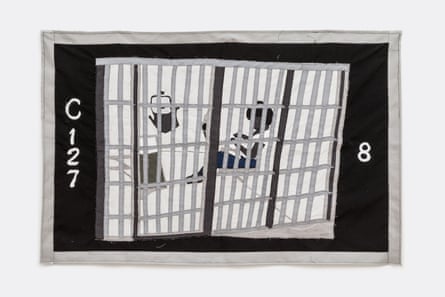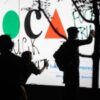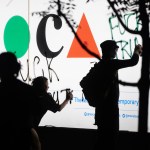In a tucked-away corner of the Frieze Art Fair in Los Angeles, among the frenzied crowds of the international art market’s trading room floor, lies a quiet respite where one booth seems to operate outside the fray. Its spare hanging of five quilted tapestries quietly asserts its place among the humming blue-chip gallery booths.
It is here that Gary Tyler, a Los Angeles-based artist and formerly incarcerated man, greets visitors and explains the significance of his work – quilted scenes depicting a Black man behind bars, rodeos, and an African Ashanti warrior gazing out at the room. This month, Tyler was awarded the prestigious Frieze Los Angeles Impact prize, an award that recognizes artists who have made significant impacts on society through their work.
Astonishingly, Tyler has managed not just to survive, but to transcend the injustices he faced. He honed his intricate textile skills during the nearly 42 years he spent wrongfully incarcerated at Angola state enitentiary, known to be one of Louisiana’s harshest prisons.

“I am exhilarated, I am honored and very appreciative to see that people recognize something I never thought would catch the eye of so many people,” Tyler told the Guardian by phone on opening day.
The prize comes with $25,000 and a solo booth at the art fair. The series of quilts Tyler chose to present is highly personal, with some containing references to the pain, and the beauty, he has witnessed. His works are a symbol of strength and resilience, aiming to give viewers a sense of what it’s like to spend life in prison. One piece, Indignity, 2017 (2024), depicts the Angola Rodeo – a prison rodeo and arts festival where Tyler first displayed the quilts he made behind bars. It shows a man getting kicked off a bull, sprawled on the ground, a brutal scene that Tyler compares to “a gladiator sport”.
“[It’s] the manifestation of my past and present life,” he says of the show. “I thought that it was very important for people to see.”
A creative outlet amid injustice
Tyler’s journey from prisoner to lauded artist has been a remarkable one. In 1974, at only 17 years old, Tyler was convicted of murder by an all-white jury and sentenced to death – making him the youngest man in the US on death row at that time. A casualty of the deeply racist south of that era, Tyler was with other Black students on a bus passing a group of white students when one of the white teenagers, Timothy Weber, was shot dead. During the ensuing investigation, Tyler, who spoke back to a police officer on the scene, ended up in an altercation, prompting a far too common situation for Black men in America – he was beaten, charged and convicted for a crime he did not commit.




Tyler remained in prison for the next four decades, to the outrage of loyal supporters and advocates such as Rosa Parks, who repeatedly called for his freedom. In 1976, his death sentence was reduced to life when Louisiana’s mandatory death penalty was ruled unconstitutional, but it wasn’t until 2016, when he was 57, that he was freed after pleading guilty in a plea bargain.
Tyler served as the president of the Angola prison drama club for 28 years, which led him to an initiative where inmates created traditional quilts that were sold at local rodeos to fund the program. This was where Tyler first learned to sew, albeit reluctantly at first. “I mean, we’re in a men’s prison,” he says with a laugh. “I had my apprehensions. Eventually I relented and started helping them, and liking what I was doing.”
Tyler looked to quilting as a creative outlet for his experiences. He began with basic quilt patterns and geometric shapes, and he soon began to experiment with more intricate imagery, and applying a technique called appliqué. “I wanted to start doing something that was going to stand out,” he says.




A quilt he entered into a competition earned the admiration of a group of women who visited Tyler in prison and brought him books on quilting. He drew inspiration from the work of Gee’s Bend, a celebrated group of Black quilters in Alabama descended from formerly enslaved people. “That’s when I started to hit the books, looking at Gee’s Bend catalogs and how they were making their quilts.”
A new life in art
After prison, Tyler decided to move from traditional shapes to deeply personal subject matter – depicting scenes that were a reflection of his life. He also uses the appliqué method to create imagery of butterflies, hearts and birds, a process that first got his work noticed by Library Street Collective, a Detroit-based gallery where Tyler staged his first solo show in 2023.




For that show, called We are the Willing, Tyler created large-scale quilts with imagery sourced from photographs taken of him while he was in prison. One piece, titled Defiant, 1976, is based on a photograph taken during his arrest that shows him in handcuffs. His fists are clenched, a pose that Tyler says was about letting his supporters know that he was not going to give up under any circumstances. His portrait is surrounded by thin black lines emanating from him like divine rays of light. The quilt is bordered by bright yellow, white and black contrasting rectangles, framing the piece like a saintly relic.
Tyler says the recognition from that show gave him confidence as an artist to continue showing his work. “It made me realize that I had a gift and that I was good at what I was doing,” Tyler says. “I was able to harness a skill that would be able to reflect my past into something good.”
The transition to “normal” life has not been without its challenges. Tyler had to learn the basics of adulthood, spending his first six years as a free man figuring out how to support himself, get a job, and pay rent. Last year, however, something told him “to come out of my shell and start making quilts and see how that worked out”. Supporters rallied together, creating a GoFundMe to raise money for Tyler to put a down payment on a studio, while people around the US began donating materials and tools to help him get back on his feet as an artist.




Four days a week, Tyler makes the grueling commute through rush hour traffic from his studio in Lincoln Heights to his job as the lead outreach and engagement support worker for Safe Place for Youth in the Venice neighborhood. Still, Tyler looks to the future. He hopes to continue producing work, building off his motto from his time at the Angola drama club. “We are the willing, doing the impossible for the ungrateful,” he says. “We have done so much, with so little, for so long that I’m now qualified to do anything with nothing.”
Tyler describes himself as reserved, and he has a humble nature that suggests a man who has been treated brutally yet managed to retain a softness towards the world. “I want to be able to inspire with that motto,” he says. “There are good things that can come out of prison, whether an individual is guilty or not – there are very creative people in prison.”
This post was originally published on this site be sure to check out more of their content.






